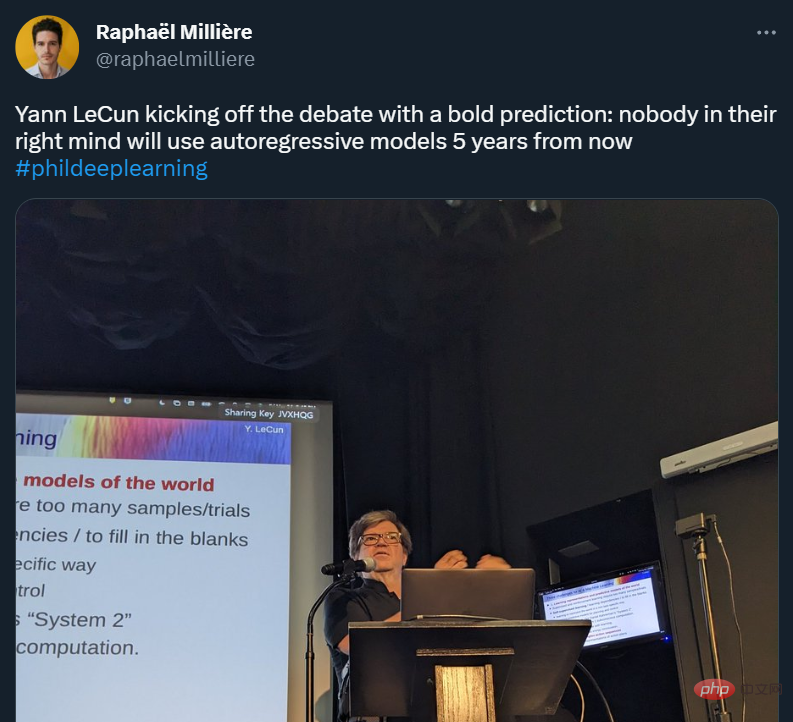 Technology peripherals
Technology peripherals AI
AI Using LLM to improve understanding, Pika, a new open source framework from Peking University and Stanford, provides a deeper understanding of the diffusion model of complex prompt words.
Using LLM to improve understanding, Pika, a new open source framework from Peking University and Stanford, provides a deeper understanding of the diffusion model of complex prompt words.Pika Peking University and Stanford team up, Open sourceThe latest text-image generation/editing framework!
Without additional training, the diffusion model can have stronger prompt word understanding capabilities.
Faced with super long and complex prompt words, the accuracy is higher, the details are better controlled, and the generated pictures are more natural.
The effect surpasses the strongest image generation models Dall·E 3 and SDXL.
For example, it is required that the picture has two layers of ice and fire on the left and right, with icebergs on the left and volcanoes on the right.
SDXL did not meet the prompt word requirements at all, and Dall·E 3 did not generate the detail of a volcano.

can also generate secondary editing of images through prompt word pairs.
This is the text-image generation/editing framework RPG (Recaption, Plan and Generate), which has caused heated discussions on the Internet.

It was jointly developed by Peking University, Stanford and Pika. The authors include Professor Cui Bin from the School of Computer Science at Peking University, Chenlin Meng, co-founder and CTO of Pika, etc.
The current framework code is open source and is compatible with various multi-modal large models (such as MiniGPT-4) and diffusion model backbone networks (such as ControlNet).
Use multi-modal large models for enhancement
For a long time, diffusion models have been relatively weak in understanding complex prompt words.
Some existing improvement methods either have insufficient final results or require additional training.

Therefore, the research team uses the understanding ability of multi-modal large models to enhance the combination and controllability of the diffusion model.
As can be seen from the name of the framework, it allows the model to "redescribe, plan and generate".

The core strategy of this method has three aspects:
1. Multimodal Recaptioning: Using large models Decompose complex text prompts into multiple sub-prompts and re-describe each sub-prompt in more detail to improve the diffusion model's ability to understand prompt words.
2. Chain-of-Thought Planning (Chain-of-Thought Planning): Using the chain-of-thought reasoning capabilities of multi-modal large models, the image space is divided into complementary sub-regions, and Each sub-region matches a different sub-cue, breaking down complex generation tasks into multiple simpler generation tasks.

3. Complementary Regional Diffusion: After dividing the space, non-overlapping areas generate images based on sub-prompts, and then Perform splicing.




Based on experimental comparison, RPG surpasses other image generation models in dimensions such as color, shape, space, and text accuracy.

Research Team
This study has two co-authors, Ling Yang and Zhaochen Yu, both from Peking University.
Participating authors include Chenlin Meng, co-founder and CTO of AI startup Pika.
She has a PhD in computer science from Stanford and has rich academic experience in computer vision and 3D vision. She participated in the Denoising Diffusion Implicit Model (DDIM) paper, which has now received 1,700 citations. A number of generative AI-related research articles have been published at top conferences such as ICLR, NeurIPS, CVPR, and ICML, and many of them have been selected into Oral.
Last year, Pika became an instant hit with its AI video generation product Pika 1.0. The background of its founding by two Chinese female PhDs from Stanford made it even more eye-catching.
△On the left is Guo Wenjing (Pika CEO), on the right is Chenlin Meng
Also participating in the research was Vice Dean of the School of Computer Science at Peking University Cui Bin Professor, he is also the director of the Institute of Data Science and Engineering.

In addition, Dr. Minkai Xu from the Stanford AI Laboratory and Stefano Ermon, an assistant professor at Stanford, jointly participated in this research.
Paper address: https://arxiv.org/abs/2401.11708
Code address: https://github.com/YangLing0818/RPG- DiffusionMaster
The above is the detailed content of Using LLM to improve understanding, Pika, a new open source framework from Peking University and Stanford, provides a deeper understanding of the diffusion model of complex prompt words.. For more information, please follow other related articles on the PHP Chinese website!
 ai合并图层的快捷键是什么Jan 07, 2021 am 10:59 AM
ai合并图层的快捷键是什么Jan 07, 2021 am 10:59 AMai合并图层的快捷键是“Ctrl+Shift+E”,它的作用是把目前所有处在显示状态的图层合并,在隐藏状态的图层则不作变动。也可以选中要合并的图层,在菜单栏中依次点击“窗口”-“路径查找器”,点击“合并”按钮。
 ai橡皮擦擦不掉东西怎么办Jan 13, 2021 am 10:23 AM
ai橡皮擦擦不掉东西怎么办Jan 13, 2021 am 10:23 AMai橡皮擦擦不掉东西是因为AI是矢量图软件,用橡皮擦不能擦位图的,其解决办法就是用蒙板工具以及钢笔勾好路径再建立蒙板即可实现擦掉东西。
 谷歌超强AI超算碾压英伟达A100!TPU v4性能提升10倍,细节首次公开Apr 07, 2023 pm 02:54 PM
谷歌超强AI超算碾压英伟达A100!TPU v4性能提升10倍,细节首次公开Apr 07, 2023 pm 02:54 PM虽然谷歌早在2020年,就在自家的数据中心上部署了当时最强的AI芯片——TPU v4。但直到今年的4月4日,谷歌才首次公布了这台AI超算的技术细节。论文地址:https://arxiv.org/abs/2304.01433相比于TPU v3,TPU v4的性能要高出2.1倍,而在整合4096个芯片之后,超算的性能更是提升了10倍。另外,谷歌还声称,自家芯片要比英伟达A100更快、更节能。与A100对打,速度快1.7倍论文中,谷歌表示,对于规模相当的系统,TPU v4可以提供比英伟达A100强1.
 ai可以转成psd格式吗Feb 22, 2023 pm 05:56 PM
ai可以转成psd格式吗Feb 22, 2023 pm 05:56 PMai可以转成psd格式。转换方法:1、打开Adobe Illustrator软件,依次点击顶部菜单栏的“文件”-“打开”,选择所需的ai文件;2、点击右侧功能面板中的“图层”,点击三杠图标,在弹出的选项中选择“释放到图层(顺序)”;3、依次点击顶部菜单栏的“文件”-“导出”-“导出为”;4、在弹出的“导出”对话框中,将“保存类型”设置为“PSD格式”,点击“导出”即可;
 GPT-4的研究路径没有前途?Yann LeCun给自回归判了死刑Apr 04, 2023 am 11:55 AM
GPT-4的研究路径没有前途?Yann LeCun给自回归判了死刑Apr 04, 2023 am 11:55 AMYann LeCun 这个观点的确有些大胆。 「从现在起 5 年内,没有哪个头脑正常的人会使用自回归模型。」最近,图灵奖得主 Yann LeCun 给一场辩论做了个特别的开场。而他口中的自回归,正是当前爆红的 GPT 家族模型所依赖的学习范式。当然,被 Yann LeCun 指出问题的不只是自回归模型。在他看来,当前整个的机器学习领域都面临巨大挑战。这场辩论的主题为「Do large language models need sensory grounding for meaning and u
 ai顶部属性栏不见了怎么办Feb 22, 2023 pm 05:27 PM
ai顶部属性栏不见了怎么办Feb 22, 2023 pm 05:27 PMai顶部属性栏不见了的解决办法:1、开启Ai新建画布,进入绘图页面;2、在Ai顶部菜单栏中点击“窗口”;3、在系统弹出的窗口菜单页面中点击“控制”,然后开启“控制”窗口即可显示出属性栏。
 ai移动不了东西了怎么办Mar 07, 2023 am 10:03 AM
ai移动不了东西了怎么办Mar 07, 2023 am 10:03 AMai移动不了东西的解决办法:1、打开ai软件,打开空白文档;2、选择矩形工具,在文档中绘制矩形;3、点击选择工具,移动文档中的矩形;4、点击图层按钮,弹出图层面板对话框,解锁图层;5、点击选择工具,移动矩形即可。
 强化学习再登Nature封面,自动驾驶安全验证新范式大幅减少测试里程Mar 31, 2023 pm 10:38 PM
强化学习再登Nature封面,自动驾驶安全验证新范式大幅减少测试里程Mar 31, 2023 pm 10:38 PM引入密集强化学习,用 AI 验证 AI。 自动驾驶汽车 (AV) 技术的快速发展,使得我们正处于交通革命的风口浪尖,其规模是自一个世纪前汽车问世以来从未见过的。自动驾驶技术具有显着提高交通安全性、机动性和可持续性的潜力,因此引起了工业界、政府机构、专业组织和学术机构的共同关注。过去 20 年里,自动驾驶汽车的发展取得了长足的进步,尤其是随着深度学习的出现更是如此。到 2015 年,开始有公司宣布他们将在 2020 之前量产 AV。不过到目前为止,并且没有 level 4 级别的 AV 可以在市场


Hot AI Tools

Undresser.AI Undress
AI-powered app for creating realistic nude photos

AI Clothes Remover
Online AI tool for removing clothes from photos.

Undress AI Tool
Undress images for free

Clothoff.io
AI clothes remover

AI Hentai Generator
Generate AI Hentai for free.

Hot Article

Hot Tools

SublimeText3 Mac version
God-level code editing software (SublimeText3)

SublimeText3 Linux new version
SublimeText3 Linux latest version

SecLists
SecLists is the ultimate security tester's companion. It is a collection of various types of lists that are frequently used during security assessments, all in one place. SecLists helps make security testing more efficient and productive by conveniently providing all the lists a security tester might need. List types include usernames, passwords, URLs, fuzzing payloads, sensitive data patterns, web shells, and more. The tester can simply pull this repository onto a new test machine and he will have access to every type of list he needs.

WebStorm Mac version
Useful JavaScript development tools

SublimeText3 English version
Recommended: Win version, supports code prompts!







